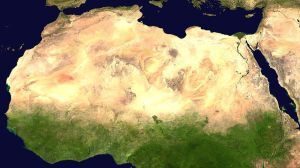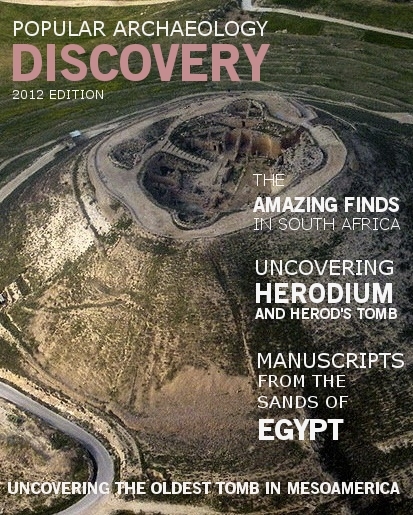
Evidence from past research has suggested that, sometime during the period between 130,000 and 100,000 years ago, the Sahara desert region we know today was wetter, featuring rivers and lakes, providing an environment that many scientists theorize permitted the earliest modern humans to migrate northward from points southward in Africa toward the Mediterranean coastline and areas eastward into the Levant.
Now, for the first time, a team of researchers led by UK scientist Tom J. Coulthard of the University of Hull, United Kingdom, has simulated the existence and fluctuation of ancient water systems across this region, rivers and wetlands with traces that still likely lie beneath sand dunes today. They used a state-of-the-art Earth System Model (ESM) to simulate the Eemian period climate (the interglacial period which began about 130,000 years ago and ended about 114,000 years ago) to drive a model that reconstructed past rivers and flood events across 12,000,000 square kilometers of North Africa, in the Sahara Desert region. This in turn predicted the presence of distinct river corridors and wetlands throughout the region during this time, “green corridors” that could have been used by early modern humans to migrate northward from their original southern homelands in Africa to jump-off locations for colonizing the globe at least 100,000 years ago.
“Previous spatial analysis of the regional topography has shown there are major watersheds that are dry today but which would drain north from these [the Ahaggar and Tibesti ranges in the south] mountains towards the Mediterranean,” says Coulthard, et. al. “Satellite imagery reveals traces of major river channels linked to these watersheds, now partially buried under sand dune deposits.” It “provides the first strong quantitative evidence for the presence of three major river systems flowing across the Sahara during MIS 5e [Marine Isotope Stage 5e, or 130,000 years ago]”.*
“Whilst we cannot state for certain that humans migrated alongside these rivers, the shape of the drainage systems indicate that anyone moving from south to north from a 2,000 km wide region in the mountains would be funnelled into three clear routes,” the researchers continue.*
Those south-to-north river systems are the “Sahabi” and “Kufrah” in the east towards Egypt and the Levant, and the “Irharhar” much farther to the west. They note that, despite the western-most location, the Irharhar river corridor could have been the most suitable corridor for dispersal of humans beyond the Sahara during this time, as the Irharhar connects two comparatively more humid climates, the monsoonal Ahaggar and Tibesti region to a North Western Mediterranean zone that received significant rainfall in the winter. They further support this by pointing to the greater abundance of archaeological evidence found in this area dated to the time range.
“In contrast, the eastern region has a surprising lack of archaeological evidence despite the extensive simulated palaeo-river courses,” they add. “It is likely that further surveys in this area will provide substantial evidence of Middle Stone Age activity, especially in the areas of buried palaeochannels. However, continued absence of this critical evidence of human migration would confirm our suggestion that a key factor in the western distribution of sites was the attractiveness of the richer Mediterranean-type environments of the Maghreb, which would have promoted permanent settlement in the region and further transit in both directions along the Irharhar river corridor.”
Previous studies have shown that people travelled across the Saharan mountains toward more fertile Mediterranean regions, but when, where and how they did so has been debatable among scholars. Current hypotheses suggest a single trans-Saharan migration, many migrations along one route, or multiple migrations along several different routes. Much more research needs to take place before a consensus model can be constructed.
But this study has shed new light on the debate.
“It’s exciting to think that 100,000 years ago there were three huge rivers forcing their way across 1,000 km of the Sahara desert to the Mediterranean — and that our ancestors could have walked alongside them,” said Coulthard.
The study has been published in detail at PLOS One, the open-access scientific journal.
___________________________________
* Coulthard TJ, Ramirez JA, Barton N, Rogerson M, Bru ̈ cher T (2013) Were Rivers Flowing across the Sahara During the Last Interglacial? Implications for Human Migration through Africa. PLoS ONE 8(9): e74834. doi:10.1371/journal.pone.0074834
_________________________________________________________________________________________________________________________
Read about the most fascinating discoveries with a premium subscription to Popular Archaeology Magazine. Find out what Popular Archaeology Magazine is all about. AND MORE:
 Popular Archaeology’s annual Discovery edition is a selection of the best stories published in Popular Archaeology Magazine in past issues, with an emphasis on some of the most significant, groundbreaking, or fascinating discoveries in the fields of archaeology and paleoanthropology and related fields. At least some of the articles have been updated or revised specifically for the Discovery edition. We can confidently say that there is no other single issue of an archaeology-related magazine, paper print or online, that contains as much major feature article content as this one. The latest issue, volume 2, has just been released. Go to the Discovery edition page for more information.
Popular Archaeology’s annual Discovery edition is a selection of the best stories published in Popular Archaeology Magazine in past issues, with an emphasis on some of the most significant, groundbreaking, or fascinating discoveries in the fields of archaeology and paleoanthropology and related fields. At least some of the articles have been updated or revised specifically for the Discovery edition. We can confidently say that there is no other single issue of an archaeology-related magazine, paper print or online, that contains as much major feature article content as this one. The latest issue, volume 2, has just been released. Go to the Discovery edition page for more information.
Subscription Price: A very affordable $5.75 for those who are not already premium subscribers of Popular Archaeology Magazine (It is FREE for premium subscribers to Popular Archaeology). Premium subscribers should email populararchaeology@gmail.com and request the special coupon code. Or, for the e-Book version, it can be purchased for only $3.99 at Amazon.com.




